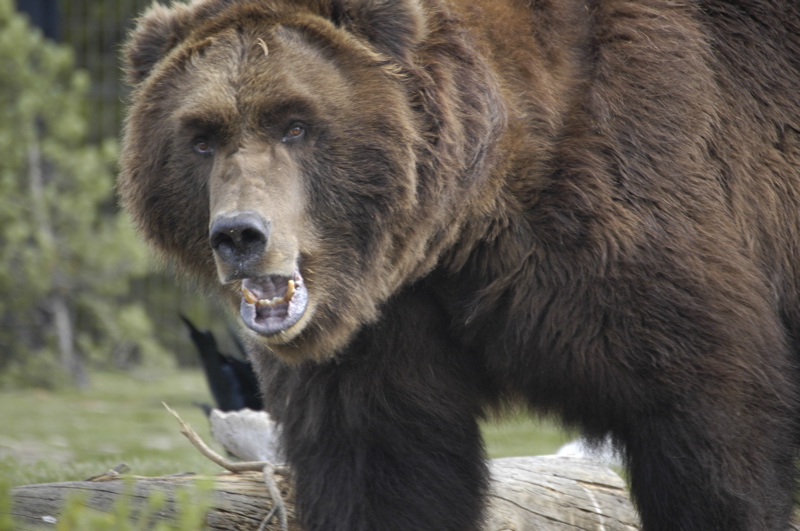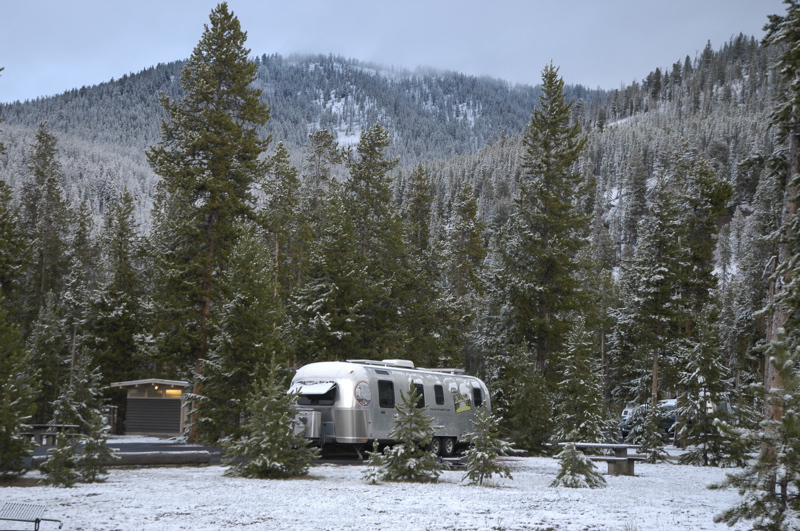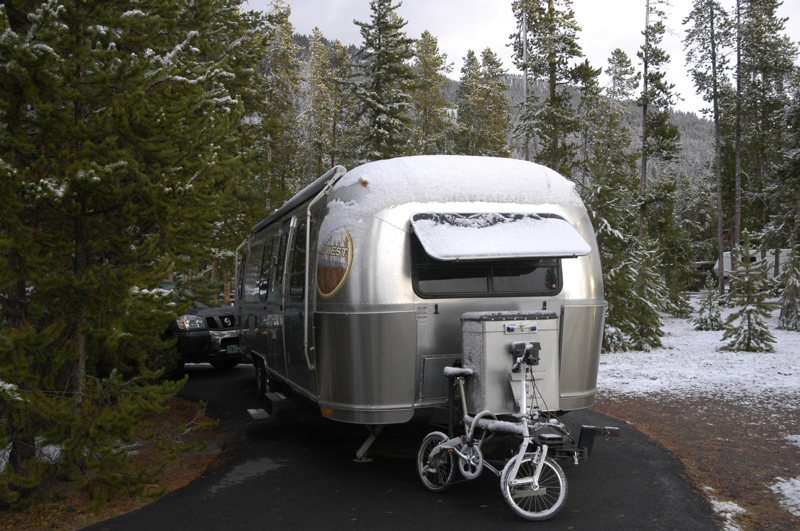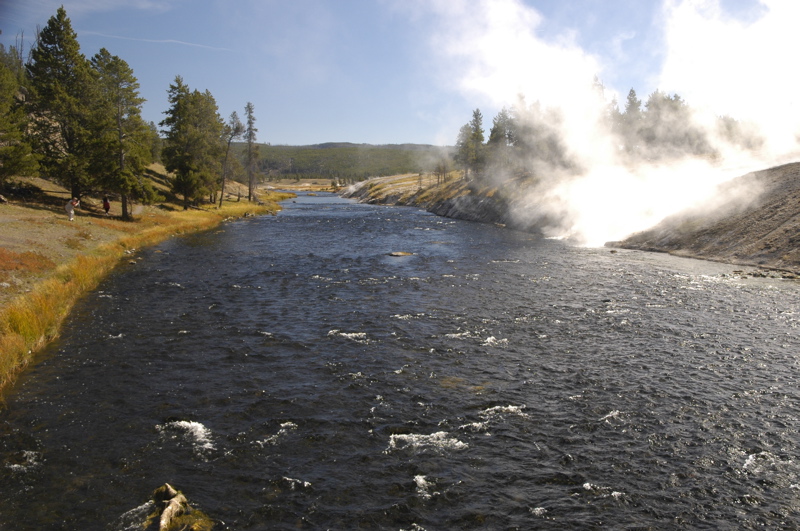Archive for October, 2007
October 3, 2007 at 10:07 pm · Filed under Mobile technology, Tips & Ideas
Our admission to the Grizzly and Wolf Discover Center was a two-day ticket, so Emma went back on Tuesday afternoon to join a special kids program. They let the kids go into the bear habitat (when the bears aren’t there, of course) and hide food under the rocks and stumps for the bears to find. This is great fun for the kids and the grizzlies. The kids get to “feed the bears” in a safe and legal fashion, and the grizzlies get to go sniff it out, which keeps their lives interesting.

Sam the grizzly bear says “Go ahead, leave some food at your campsite!”
Recovering from a long period offline is serious work. There are the usual emails and phone calls to be caught up on, and replenishing our supplies, and it all tends to happen in a big hurry because we want to be able to do more stuff as soon as possible. So today I spent about 12 hours parked in front of the computer while Emma finished her latest Junior Ranger projects (two of them, for two different Yellowstone patches) and Eleanor dealt with heaps of laundry.
This evening I emerged from the trailer at sunset and found Bert preparing to go into town for a tank of propane, so I put my empty 30# propane tank in his truck and joined him for the ride.
West Yellowstone is a very small town concentrated in about six square blocks at the gate of Yellowstone National Park. It has the look of an Alaskan village, with shabby buildings that show the wear of long hard winters, randomly intermingled with well-kept shops aimed at the tourist trade, and restaurants that sport neon signs. There are three gas stations in two blocks distance, a sign that this is the outpost of Yellowstone and the next gas station is a long way off.
This time of year West Yellowstone is shutting down. The tourists are mostly gone, the skies have gone gray, and the sun is setting before 7 p.m. We counted ourselves lucky to find a place still selling propane after 6 p.m. (a corner convenience store). Bert mentioned this to one of the locals, who snorted, “Are you kidding? West Yellowstone!” as if “West Yellowstone” was a self-explanatory expletive, a code word for avarice or commercialism.
“Not while there’s money to be made,” he went on, but I think his attitude was too vehement to be fair to the town. Yes, it caters to the tourist trade — why else would it be here? — but looking around I can see that the people who make a living here do so at the price of a long winter. I can’t begrudge them trying to make a living during the few short months of summertime activity.
Our campground is more than half empty. I’m sure most of the people who are still here are commuting into Yellowstone, as Bert did today. He was hunting again for the Great Gray Owl, but found a female moose and calf instead. We are seriously considering going back into the park tomorrow together to try for some good photos of the moose, but we’ll need to book another night here first.
I have discovered something annoying about the factory power converter. Our trailer has a Parallax 7300 series converter. It contains a 2-stage battery charger, which means it’s the thing responsible for setting the rate of charge of our batteries when we plug in.
We came out of Yellowstone with our batteries drained about 125 amp-hours and I expected that we’d be re-charged in a day or so. But the Parallax only rapid-charged the batteries for a couple of hours. After that, based on the voltage of the batteries, it stepped down to its “trickle-charge” rate, even though the batteries were still about 70 amp-hours from full.
Since then it has charged at a pathetically slow rate, between 0.37 amps and 1.5 amps. (Our Tri-Metric 2020 system monitor tells us this.) This means our batteries will take days to fully recharge. If we relied on the very basic monitor that comes with nearly all RVs, we’d think we were recharged because a silly little (inaccurate) telltale light would glow green, but the Tri-Metric actually knows better and it tells us the truth.
I’ve been asking for opinions on how to improve this situation from RV electrical system experts, and so far the explanation is that I need to upgrade the Parallax to a 3-stage charger, which is possible but costs over $200 just for the necessary parts. With a third stage that charges at a higher voltage, the Parallax will be much more effective.
Interestingly, we already have a separate 3-stage charge controller in the Airstream (a Blue Sky SolarBoost 2000e) specifically for the solar panels. The Blue Sky unit takes over when sun starts to hit the solar panels. So when the sun comes out, our rate of charge increases dramatically, up as high as 10 amps (actual amperage depends on the amount of sun), and when the sun goes behind a cloud we’re back to the trickle charge level determined by the Parallax. In other words, we can charge much more quickly using a little sunshine than we can when plugged into a 30-amp power cord!
The past few 36 hours have not been very sunny, which (as Dr Seuss would say) seems rather unfunny. We are plugged into all the electrical power we could want, enough to run a heat pump and toaster, but the stupid power converter won’t let our batteries have any!
One partial solution to this quandary is to reduce our power requirements in the future. As several correspondents have pointed out to me, a catalytic heater would eliminate the need to run the energy-robbing furnace and thus reduce our cold-weather power needs by more than half. I agree, and I wish we’d installed a catalytic heater a year ago when I first considered it. We had cat heaters in our previous two Airstreams and loved them for their efficiency and quietness.
For now I am going to take a week or two to consider what to do. Both options presented so far (upgrading the Parallax and adding a catalytic heater) will cost $300-400 each by the time we are done. Also, we are heading into a rather hectic travel period and don’t foresee any long stops for at least several weeks, which makes pausing for service a problem.
I think the immediate thing to do is to go look for moose in Yellowstone while I’ve still got the chance. I’ll get up early in the morning to finalize some work and join Bert for one last photo safari. I can worry about the power situation later.
One final note: this evening Bert, Janie, and I were talking about all the places we’ve met and camped together. We came up with nine states we’ve met in: Maine, Vermont, New Jersey, Florida, Texas, New Mexico, Arizona, Wyoming, and Montana. I love the fact that we are long-distance friends and yet manage to get together for good camping fun all over the country.
October 2, 2007 at 7:12 pm · Filed under Mobile technology, Tips & Ideas
We are back in touch with the world, and I have backdated several blog entries from our trip to Yellowstone. Scroll down to see all the new entries (since September 27).
Last night’s gentle rain turned into freezing rain and then snow, so that this morning when I opened the curtains I found the world outside completely changed from fall to winter with about a half-inch of snow. The balmy sunny weather of just a few days ago seems far off now, with the nearby mountains shrouded in fog and a definite Christmas-y feel to the air.

Our entry step was completely coated in ice when I went out, and I found Bert standing at his awning looking at a heap of snow and ice that had coated it and distorted the fabric. He had put his awning out the day before to protect his generator from the rain, but hadn’t anticipated that the rain would become ice.
Like us, Bert and Janie were planning to leave Madison campground today. They were headed off to Grand Teton’s last open campground (Signal Mountain) to find some moose. But first, they had to figure out how to remove inches of snow and ice from their awning and their slide-out. We ended up beating on the ice and sweeping repeatedly, while waiting for the temperature to rise above freezing. Eventually enough was removed for him to roll up the awning and go, but it was far from clean and dry.
I had the same problem with the folding bicycle I’d left cabled to the hitch overnight, but it was easier to de-ice. I hauled it into the Airstream and let it melt on a towel for an hour.

Yellowstone is just as beautiful in the snow as it was last week in the sun. The meadows glow gold when struck by the light, and the broad flat rivers still glisten and burble and sprout fly-fishermen in hip waders. The mountains are draped with cloud and the bison are coated with frost on their dark woolly manes.
It all works so well that I almost began to despair at the excess of photographic opportunities. There simply wasn’t enough time, even in six days and nights, to begin to capture this place. I shot over eight hundred photographs (culled to about 400 hundred at this point, and still going). It wasn’t enough.

Steaming hot water pours down from Grand Prismatic Geyser into the Firehole River
We came out of the six-night “no-hookup” camping experience in Yellowstone surprisingly well. Despite trees shading our solar panels, freezing temperatures every night, and a few cloudy days, we emerged with this final status:
28 degrees at 8:00 a.m. Snow on panels. -133 amp-hours cumulative (50 amp-hours used overnight)
That’s not bad at all. As I noted when we left Cody, our safe useful battery power is 150 amp-hours (out of 300 total in the bank), and even after six nights we didn’t hit our limit. The key was serious conservation, primarily by keeping the furnace set low at night. We settled on 50 degrees as our overnight setting, which wasn’t bad at all with a lot of blankets on the beds. Bert and Janie set theirs at 40 degrees and sleep in sleeping bags. This morning we met a fellow in a fifth wheel who says his insulation is virtually non-existent and so they just turn off the furnace at night. Compared to them, we are total weenies.
Water-wise we did even better. Our 39-gallon fresh water tank was still about 1/3 full when we left. We took a total of six showers between us (with minor sponge baths from the sink between showers), used the bathroom at night, and did a few dishes when we didn’t feel like going out to the campground sink. It was really great to test our ability to camp on minimal resources, like the old days when we were tenting, and know what our Airstream can do.
Some of you may be reading this and thinking, “How horrible — sponge baths, a cold trailer, no TV,” but really it’s fun. It’s a game to see how long we can stretch a gallon of water, how long we can make a battery last, and how well we can keep ourselves entertained in a place with relatively few of the modern distractions.
After six nights it was time to go find a place to replenish our supplies. We’re now in a commercial campground in the little town of West Yellowstone MT, just a half mile from the park gate. This place has what we need for the next few days: electrical power, stores, cell phone service, Internet, propane. I’m going to sit down before my computer and get some progress on the layouts for the upcoming Winter 2007 magazine, and we’ll also re-stock for a few more days of boondocking in Montana next week.
Bert & Janie got skunked on their plan to head down to Grand Teton. The snow last night caused road closures heading south, and they were forced back north. They also heard from Eric and Sue that the moose were being elusive. So now they’re here, parked right next to us for the next two days, doing the same things we are. Well, except for one thing: Bert had to open his awning up again to melt the last of the ice that got rolled up in it this morning. Now it looks normal again.
Once we’re all caught up, the plan is to head up to some ghost towns in Montana, but I’ll tell you about that later.
October 1, 2007 at 8:35 pm · Filed under Places to go
22 degrees at 8:00 a.m. / -107 amp-hours cumulative (40 amp-hours used overnight)
We would be leaving the park today but we’ve booked another night. The weather has turned colder now, and we’re expecting some snow overnight. It is starting to feel like winter up here at 7000 feet. Hard to believe it’s just the first day of October. But even though we are over a hundred amp-hours into our battery bank, we still have conservatively 50 more amp-hours to burn before we start to get into our emergency power reserve.
Eric and Sue, being official travel writers, as are Bert & Janie, have obtained a complimentary admission for all of us to the Grizzly and Wolf Discovery Center in West Yellowstone. That’s just 14 miles from Madison campground, in the little outpost town at the west entrance of the park.
Since I haven’t seen a grizzly in the wild yet (and perhaps I would rather not), this seemed to be the ideal way to observe them up close and get some good photos. That’s what the travel writers were all hoping for too. Bert is working on an article for a competitor RV magazine and Eric and Sue are working on something as well. All of them need photos of wild creatures to illustrate their writings.
(By the way, traveling with travel writers is the way to go. Every day I am getting amazing tips on places to go and things to do in the northwest. You’ll see some of their tips appearing in our travels in the next few months.)
 The Grizzly and Wolf Discovery Center is a not a roadside zoo, but a non-profit organization that works with Yellowstone rangers, makers of bear-related products, and other conservation organizations for the protection of wild animals. It’s a great place to stop on your way in or out of Yellowstone National Park’s west entrance. There’s a good visitor center and outside there are habitats with grizzly bears and wolves. The admission is good for two days, so Eleanor and Emma may go back tomorrow.
The Grizzly and Wolf Discovery Center is a not a roadside zoo, but a non-profit organization that works with Yellowstone rangers, makers of bear-related products, and other conservation organizations for the protection of wild animals. It’s a great place to stop on your way in or out of Yellowstone National Park’s west entrance. There’s a good visitor center and outside there are habitats with grizzly bears and wolves. The admission is good for two days, so Eleanor and Emma may go back tomorrow.
In the photo, you can see why hanging a bird feeder is not a good idea in bear country. This 1,000-lb male is about to knock this dead tree over in order to get a snack of birdseed. It took him less than a minute to uproot it. Several times a day, the Center puts different bears into the public habitat with hidden snacks, and you can watch as the bears instantly detect the food using only their nose and casually toss aside boulders and stumps to uncover it. It’s absolutely amazing to see how powerful these creatures are. Heck, just a look at their huge front claws is enough to make you never want to encounter a grizzly bear in the wild.
All of the bears here would have been killed if they hadn’t been moved here. They were mostly bears that had become habituated to humans and were raiding trash or killing farm animals. Coming to the Center was their reprieve from being destroyed. As they say, “A fed bear is a dead bear.” Please don’t feed the animals!

We got a guided tour from John, who showed us an exhibit of “bear-proof” trash containers they’ve tested. Testing is easy: just put some food in the container and leave it in the bear habitat. It’s just like those old Samsonite luggage commercials where they put the suitcase in a cage with an ape. Most containers fail the test. It’s humbling to see what the bears can do.


The Center also has a nice exhibit with wolves, and several raptors that for various reasons can’t be returned to the wild. I can’t do justice to it all in a single blog entry, so I’ll just say that the place is worth the price of admission.
Since were in West Yellowstone, where cell phones work, I downloaded 475 emails (377 of which were spam or useless) and resigned myself to going back to work on Tuesday. We picked up a frozen pizza at the local supermarket for dinner and since it was our last night in the park, I decided to splurge on the power budget and watch a DVD on the laptop.
Our solar gain report for the day:
Mostly cloudy. At 4:30 p.m. cumulative amp-hours were -83. 24 amp-hours gained.
« Previous entries









